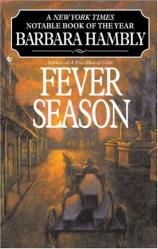Fever Season
Review
Fever Season
New Orleans in the 1830s was a dichotomy. The population of the
city was ever-increasing, due to the city's burgeoning reputation
as a port and the influx of American citizens as the result of the
Louisiana Purchase. There were fortunes to be made; and,
unfortunately, lives to be lost. For New Orleans was also a very
violent city, attracting a criminal element eager to live off the
fat of the land. And, in the summertime, the mysterious twin
scythes of pestilence --- cholera and yellow fever --- would
mysteriously appear, wreak havoc on the population, and disappear
with the arrival of fall.
Barbara Hambly, who introduced Benjamin January in her brilliant
novel A FREE MAN OF COLOR, returns her readers to January --- and
to New Orleans in the summer of 1833 --- in FEVER SEASON. Ms.
Hambly, in FEVER SEASON, continues her practice of focusing on a
major element of historical New Orleans life. In A FREE MAN OF
COLOR, Ms. Hambly used the quadroon balls --- a fascinating though
repellent aspect of old New Orleans society --- as a story vehicle.
In FEVER SEASON, she uses the mysterious pestilence that annually
scourged New Orleans as a backdrop to an incredible tale of deceit,
treachery, and murder.
FEVER SEASON finds Benjamin January utilizing his medical
background by aiding the dying --- to the extent the field of
medicine could at that place in time --- at Charity Hospital. While
working there he encounters young Cora Chouteau, who has come to
New Orleans in search of her "husband" who has been sold into
slavery. January, although certain that Cora is a runaway slave
herself, agrees to try to help her to pass a message to her
beloved. January soon learns, however, that Cora is accused of
murdering her master and poisoning his wife. He is soon swept into
a maelstrom of intrigue in which he attempts to separate truth from
lies and fiction from reality. This process finds him involved in
the lives of personalities as varied as Emily Redfern, the vulgar
American widow from whom Cora is fleeing, to Madame LaLaurie, the
queen of Creole society; and from Marie Laveau, the voodoo queen of
New Orleans, whose tentacles of influence, knowledge, and wisdom
spread throughout the city, to Rose, a schoolmistress attempting to
instill knowledge in young girls of color, in a place and a time
where knowledge --- at least for them --- was not highly prized or
valued.
The intricate plotting, incredible detail, and intriguing
characterizations which are the hallmark of Ms. Hambly's work are
all here in FEVER SEASON as she makes a dangerous and fascinating
place and era come alive for modern readers. One cannot say enough
about Ms. Hambly's meticulous research, and, by equal measure, the
skill with which she infuses the fruits of it into her work of
fiction. All history should be related so well, and with such
love.
Reviewed by Joe Hartlaub on January 21, 2011





